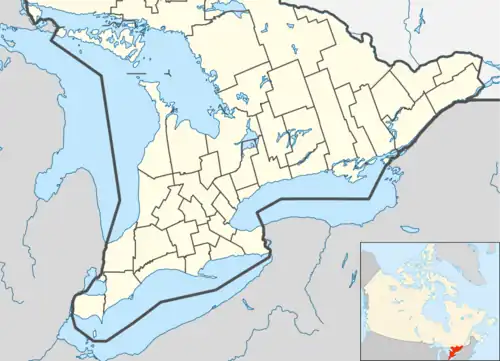Aamjiwnaang First Nation
The Aamjiwnaang First Nation (formerly known as Chippewas of Sarnia First Nation) is an Anishinaabe (Ojibwe) First Nations Band located on reserve land by the St. Clair River in Ontario, Canada, three miles south of the southern tip of Lake Huron. The reserve is located across from the United States border from Port Huron, Michigan, and is a result of treaties that were negotiated with the Crown in the 1820s. There are approximately 2,000 band members with about 850 living on the reserve. Their heritage language is Ojibwe.
Aamjiwnaang | |
|---|---|
| Sarnia Indian Reserve No.45 | |
| Nickname: The Rapids | |
 Aamjiwnaang | |
| Coordinates: 42°55.5′N 82°24′W | |
| Country | |
| Province | |
| County | Lambton |
| Indian Reserve | Sarnia 45 |
| Government | |
| • Type | Council |
| • Chief | Christopher Plain |
| • Federal riding | Sarnia—Lambton |
| • Prov. riding | Sarnia—Lambton |
| Area | |
| • Land | 12.57 km2 (4.85 sq mi) |
| Population (2016)[1] | |
| • Total | 639 |
| • Density | 50.8/km2 (132/sq mi) |
| Time zone | UTC-5 (EST) |
| • Summer (DST) | UTC-4 (EDT) |
| Postal Code | N7T |
| Area codes | 519 and 226 |
| Website | www.aamjiwnaang.ca |
The word Aamjiwnaang (am-JIN-nun) means "meeting place by the rapid water", which describes the surrounding communities.
Environmental issues
The Aamjiwnaang community has expressed concern regarding its proximity to petrochemical, polymer, and chemical plants in the area, as birth rates of their people have been documented by the American journal Environmental Health Perspectives as deviating from the normal ratio of close to 50% boys, 50% girls.[2] The ratio as found between 1999 and 2003 by the journal was roughly 33% boys, and 67% girls.[3] The First Nation is concerned that this abnormal trend is due to adverse effects of maternal and fetal exposure to the effluent and emissions of the nearby chemical plants. This is the first community in the world to have a birth rate of two girls to every boy.
Demographics
| 2021 | 2016 | 2011 | |
|---|---|---|---|
| Population | 648 (+1.4% from 2016) | 639 (-0.2% from 2011) | 640 (-9.3% from 2006) |
| Land area | 12.58 km2 (4.86 sq mi) | 12.57 km2 (4.85 sq mi) | 12.57 km2 (4.85 sq mi) |
| Population density | 51.5/km2 (133/sq mi) | 50.8/km2 (132/sq mi) | 50.9/km2 (132/sq mi) |
| Median age | 38.8 (M: 38.4, F: 39.2) | 38.0 (M: 36.7, F: 39.3) | 32.8 (M: 30.9, F: 36.1) |
| Private dwellings | 265 (total) | 255 (total) | 254 (total) |
| Median household income |
| Year | Pop. | ±% |
|---|---|---|
| 1991 | 494 | — |
| 1996 | 621 | +25.7% |
| 2001 | 695 | +11.9% |
| 2006 | 706 | +1.6% |
| 2011 | 640 | −9.3% |
| 2016 | 639 | −0.2% |
| 2021 | 648 | +1.4% |
| [9][1] | ||
Notable members
- Lisa Jackson (filmmaker)[10]
- Christopher Plain - Current Chief [11]
- June Simon - Band Manager [12]
- Carolyn Nahmabin - Membership [13]
- Fred Plain - Former President of the Union of Ontario Indians
- David D. Plain - Author of The Plains of Aamjiwnaang:Our History [14]
See also
References
- "Census Profile, 2016 Census - Sarnia 45, Indian reserve (Census subdivision), Ontario and Lambton, County (Census division), Ontario". Canada 2016 Census. Statistics Canada. Retrieved 9 July 2017.
- C. A. Mackenzie; A. Lockridge & M. Keith (2005). "Declining Sex Ratio in a First Nation Community". Environmental Health Perspectives. 113 (10): 1295–8. doi:10.1289/ehp.8479. PMC 1281269. PMID 16203237.
- "Aamjiwnaang First Nations concerned about chemical exposure". CBC News. 2005-09-02. Archived from the original on 2010-05-02. Retrieved 2008-10-21.
- "2021 Community Profiles". 2021 Canadian Census. Statistics Canada. February 4, 2022. Retrieved 2022-04-27.
- "2016 Community Profiles". 2016 Canadian Census. Statistics Canada. August 12, 2021. Retrieved 9 July 2017.
- "2011 Community Profiles". 2011 Canadian Census. Statistics Canada. March 21, 2019. Retrieved 9 July 2017.
- "2006 Community Profiles". 2006 Canadian Census. Statistics Canada. August 20, 2019.
- "2001 Community Profiles". 2001 Canadian Census. Statistics Canada. July 18, 2021.
- Statistics Canada: 1996, 2001, 2006 census
- "In Conversation with Lisa Jackson". Immerse. March 2, 2020. Retrieved 15 March 2023.
- Plain, Chris. "Current Chief" (PDF). Directory Administration. Retrieved August 26, 2020.
- Simon, June. "Band Manager" (PDF). Directory Administration. Retrieved August 26, 2020.
- Nahmabin, Carolyn. "Membership" (PDF). Directory Administration. Retrieved August 26, 2020.
- Plain, David D. (August 9, 2007). The Plains of Aamjiwnaang: Our History. Victoria, British Columbia. ISBN 978-1425122737. Retrieved August 26, 2020.
{{cite book}}: CS1 maint: location missing publisher (link)
External links
- Aamjiwnaang First Nation - Home
- 2001 Community Profiles for Sarnia 45 from Statistics Canada
- Aboriginal Affairs and Northern Development Canada profile